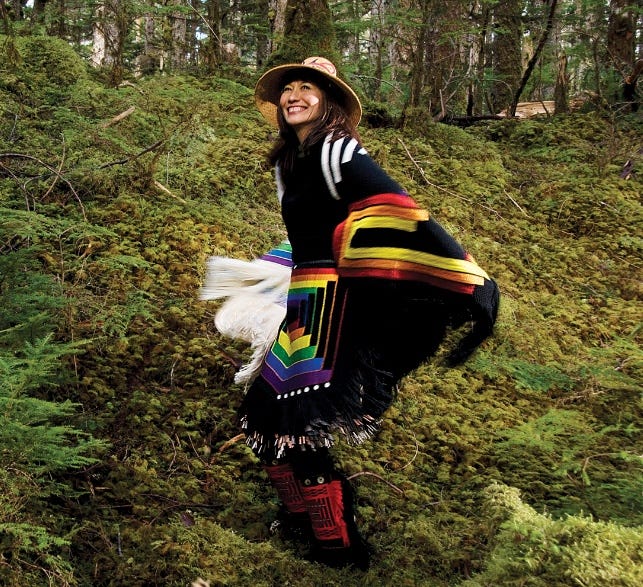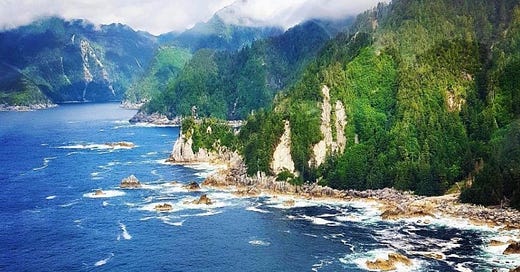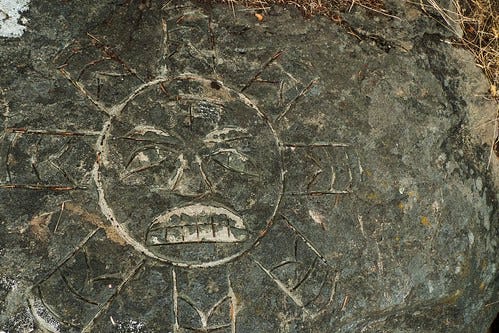Spirits in Stone: The Sacred Craft of the Haida People - Part 8 of 10 LORAS
TEMJ 20567 - Haida Art, glyphs, Totem poles, Argillite carvings, Haida culture, Heritage site, Rock art, Rock Carvings, Haida stone cairns, Haida ceremonies
Greetings Fellow Earthmonks,
Welcome to the Earthmonk Journal, your passport to the extraordinary stories of people and places. In each edition of The Earthmonk journal we will explore nature's wisdom and it’s wonders! Join me as we traverse landscapes of discovery, guided by curiosity, and fueled by passion for the wild. So grab your metaphorical backpack and embark on an unforgettable adventure with me.
The Language of Rocks and Stones
Over the coming weeks and months, we will explore the series entitled "The Language of Rocks and Stones”, LoRaS. In the LoRaS series we will travel across continents and cultures. Each edition in the series will explore the spiritual, cultural, and ecological significance of geological formations to the indigenous peoples who revere them. This series is not just an exploration of geology; it is an invitation to connect more deeply with the spiritual essence of the land and to honor the ancient wisdom that continues to guide us in our stewardship of the earth. We will delve into how these rocks and stones are more than mere physical entities; they are living, breathing parts of a larger cosmology, integral to ceremonies, storytelling, and the very identity of these cultures.
Throughout the 10 part LoRaS series, we aim to illuminate the profound wisdom embedded in these traditions, highlighting the ways in which indigenous peoples have communicated with and interpreted their natural surroundings. We will uncover how sacred sites are chosen, how rituals and ceremonies are conducted, and how stories and legends have been passed down through generations, all centered around these magnificent geological formations. This series delves into the rich and profound relationships that indigenous peoples around the world have with the geological features of their homelands.
Join me as we embark on this journey to understand the "Language of Rocks and Stones." Through the voices of elders, spiritual leaders, and cultural custodians, we will learn to see the world through the eyes of those who have long understood the sacred relationship between the earth and its inhabitants.
"Petroglyphs are the sacred glyphs etched by the spirits, telling stories beyond the visible." - Terri-Lynn Williams-Davidson
Haida Gwaii, Canada (Haida)
History of the Haida People
The Haida people are indigenous to Haida Gwaii, an archipelago off the northern coast of British Columbia, Canada, and parts of southern Alaska. Haida Gwaii, often referred to as the "Islands of the People," is known for its rugged terrain, dense temperate rainforests, and dramatic coastline. The land is characterized by towering cedar and spruce trees, steep mountains, and countless rivers and streams that crisscross the islands. The coastline is dotted with rocky beaches, secluded coves, and fjords, with the Pacific Ocean surrounding the islands, providing a rich and diverse marine ecosystem. The climate is maritime, with mild, wet winters and cool, damp summers. Rain is frequent year-round, contributing to the lush, green landscape, while storms from the Pacific often batter the coast, shaping the dynamic relationship between the Haida people and the natural world around them.
“Connection to nature, in all her power and mystery, encourages us to take responsibility not just for who we are, but also for who or what we can become. I believe that our very survival depends upon our own transformation.” — Terri-Lynn Williams-Davidson
Haida Gwaii, cradles the vibrant history of the Haida people, whose deep-rooted connection to the land has shaped their cultural heritage for millennia. The Haida worldview is intertwined with their lush environment, from towering totem poles to the rich mythology embedded in sacred landmarks. Haida Gwaii's rocky landscapes, coastal features, and geological formations are not merely physical spaces; they are seen as living entities that echo the presence of ancestral spirits.
Over centuries, the Haida have preserved this connection through intricate storytelling, ceremonial practices like potlatches, and the crafting of totem poles, each imbued with spiritual and cultural significance. These traditions link the past to the present, ensuring the continuity of Haida identity in their sacred homeland.

The Haida Heritage Site, encompassing Gwaii Haanas National Park Reserve and Haida Heritage Site, is a profound embodiment of Haida culture and environmental stewardship. Located in the southern archipelago of Haida Gwaii, off the coast of British Columbia, this protected area is renowned for its ancient Haida villages, art, and sacred sites. The region includes iconic totem poles, traditional longhouses, and ceremonial grounds that offer a glimpse into Haida life before European contact. Beyond its cultural treasures, the landscape is a vibrant ecological of lush temperate rainforests, diverse marine environments, and rugged coastlines. This co-managed site, governed by a unique partnership between the Haida Nation and the Canadian government, represents a living commitment to preserving both the cultural heritage and natural beauty of the Haida Gwaii archipelago. It reflects the Haida people's enduring connection to their ancestral lands and their active role in conservation and cultural revival.
Keep reading with a 7-day free trial
Subscribe to The Earthmonk Journal to keep reading this post and get 7 days of free access to the full post archives.





